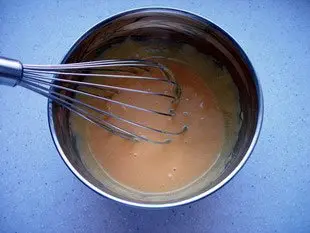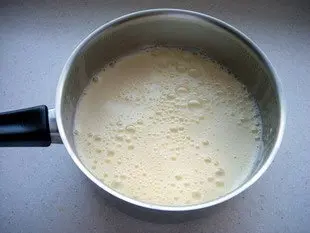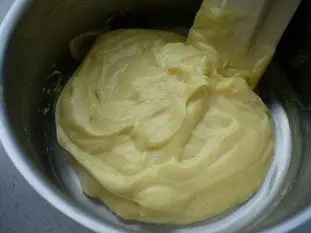This site uses only a few technical cookies necessary for its operation. By continuing to browse, you accept their use.
To find out more...
To find out more...
Is it really necessary to cream egg yolks?

Let’s try and answer a question that crops up in cookery and patisserie, even if it verges on the existential: do the egg yolks in a custard recipe really need to be beaten until pale, or not?
44 K 4.3/5 (21 reviews)
Last modified on: February 28th 2018
Is it really necessary to cream egg yolks?
You might already have noticed in many recipes combining egg yolks and sugar, how they insist that these must be beaten (or “creamed”) together until pale.
For instance, in a traditional real custard (crème anglaise) or confectioner's custard (french pastry cream) recipe, you will find it comes up frequently: first you are instructed to boil the milk, then to beat the egg yolks and sugar together for a good while until the mixture turns pale. This happens as the beating incorporates air into the mixture in the form of tiny bubbles, which create the paler colour.
Then we pour the hot milk into the mixture and mix well. Result: a liquid (milk+yolks+sugar) and, most noticeably, a lot of froth, which we don’t need, from all the bubbles created earlier.
This froth will drive you up the wall for the whole time you are trying to cook the custard, as it hides the surface and only disappears when the custard starts to thicken. In a word, this froth on the top is a pain!
So, what can we do about it? Well, that’s easy: it's better just to mix the egg yolks and sugar briefly with a whisk or soft spatula, then continue with the recipe. Beating the yolks for longer until pale doesn’t add anything significant to the recipe.
While we’re on the subject, here are answers to a few basic questions:
- Does beating the egg yolks until pale serve any purpose ? No.
- Will it make any difference to the texture in my recipe if the yolks are beaten or not? No (I tested this by making a confectioner’s custard without creaming the yolks: impossible to tell the difference in either taste or texture).
- Will beating the yolks or not make a difference to how the recipe tastes? No, none whatsoever.
- Will beating the yolks until pale make any real difference to my recipe? No, other than making it take longer, for nothing…
In other words, when a recipe tells you to beat the egg yolks until pale, you can quite happily dispense with this step, as it serves no useful purpose, other than wasting your time and creating annoying froth while you cook the custard.
To sum up: Is it necessary to the cream egg yolks when making a custard? The clear answer is no. In fact, it serves no purpose in the vast majority of recipes (I’ve been looking for an exception where it might be useful, but not found one).
PS: Just one slight damper on what I’ve just said, chipped in by my son Nicholas, who is a professional cook (and his dad’s pride and joy!). He tells me that he systematically creams his egg yolks because that’s how he was taught. The froth, which is admittedly annoying, disappears just as the custard is cooked, so this is a pretty good indicator that it’s time to stop the cooking. Now that makes sense…
For instance, in a traditional real custard (crème anglaise) or confectioner's custard (french pastry cream) recipe, you will find it comes up frequently: first you are instructed to boil the milk, then to beat the egg yolks and sugar together for a good while until the mixture turns pale. This happens as the beating incorporates air into the mixture in the form of tiny bubbles, which create the paler colour.

Then we pour the hot milk into the mixture and mix well. Result: a liquid (milk+yolks+sugar) and, most noticeably, a lot of froth, which we don’t need, from all the bubbles created earlier.

This froth will drive you up the wall for the whole time you are trying to cook the custard, as it hides the surface and only disappears when the custard starts to thicken. In a word, this froth on the top is a pain!
So, what can we do about it? Well, that’s easy: it's better just to mix the egg yolks and sugar briefly with a whisk or soft spatula, then continue with the recipe. Beating the yolks for longer until pale doesn’t add anything significant to the recipe.
While we’re on the subject, here are answers to a few basic questions:
- Does beating the egg yolks until pale serve any purpose ? No.
- Will it make any difference to the texture in my recipe if the yolks are beaten or not? No (I tested this by making a confectioner’s custard without creaming the yolks: impossible to tell the difference in either taste or texture).
- Will beating the yolks or not make a difference to how the recipe tastes? No, none whatsoever.
- Will beating the yolks until pale make any real difference to my recipe? No, other than making it take longer, for nothing…
In other words, when a recipe tells you to beat the egg yolks until pale, you can quite happily dispense with this step, as it serves no useful purpose, other than wasting your time and creating annoying froth while you cook the custard.
To sum up: Is it necessary to the cream egg yolks when making a custard? The clear answer is no. In fact, it serves no purpose in the vast majority of recipes (I’ve been looking for an exception where it might be useful, but not found one).

PS: Just one slight damper on what I’ve just said, chipped in by my son Nicholas, who is a professional cook (and his dad’s pride and joy!). He tells me that he systematically creams his egg yolks because that’s how he was taught. The froth, which is admittedly annoying, disappears just as the custard is cooked, so this is a pretty good indicator that it’s time to stop the cooking. Now that makes sense…
Lasts posts
Butter vs. grease
We often read in a recipe where a pastry is put into a mould that, just before pouring, the mould should be buttered or greased. But what's the difference between these 2 terms?December 1st 20251,0425
Getting out of the fridge early
Very often when you're cooking, you need to take food or preparations out of the fridge, to use them in the recipe in progress. There's nothing tricky about this: you just take them out of the fridge and use them, usually immediately, in the recipe. But is this really a good method?November 24th 20251,1475
Who's making the croissants?
When you look at a bakery from the outside, you naturally think that in the bakery, the bakers make the bread, and in the laboratory, the pastry chefs make the cakes. It's very often like that, with each of these professions having quite different ways of working, but sometimes there's also one...November 23th 20251,038
Oven height
When we put a dish or cake in the oven, we naturally tend to put it on the middle shelf, and that's what we usually do. But in some cases, this position and height can be a little tricky, so let's find out why.October 8th 20252,8165
The importance of sieving
In recipes that use a fine powder (flour, powdered sugar, etc.), you'll often see the advice to sift before using it. To sift is to pass the powder in question through a sieve (a very fine strainer) before incorporating it into your recipe. It's often advice, but is it really useful?September 3rd 20257,5683
Other pages you may also like
What is the difference between bakery and patisserie?
This is a question that you may well have asked yourself and which I will attempt to answer. In France the two trades of "boulangerie" (bakery) and "pâtisserie" (patisserie and confectionery) have always been quite distinct, but where exactly do the boundaries lie? .February 7th 2017134 K 14.1
Candied fruits: don't get ripped off
Do you like candied fruit? You might like to nibble a handful or add it to a recipe, like a classic fruit cake or delicious Italian specialities like panettone or sicilian epiphany pie.June 21th 201767 K 24.2
Kitchen ovens
You certainly have one in your kitchen, an oven, the essential tool for all kinds of cooking, whether in the kitchen of course, but also in pastry, bakery, pizza, and many others. Here is some information on its structure and operation.May 16th 202034 K4.4
Drawing a pattern in pastry
Often in the kitchen, in pastry-making, or in baking, we need to trace a pattern on a pastry. It's just a question of aesthetics but it has its effect after baking on a galette, pithiviers, pâté en croute (terrine in a pie crust), etc.May 23th 201935 K4.1
The so-called "nervous" meats
You've probably heard this before, we're talking about "nervous" meat, or meat with nerves, to describe what is indicated by the blue arrow on the left. This is a piece of beef, and what we call a nerve is not a nerve, it is in fact collagen (chemists sometimes call it a "collagen sink"), a...April 16th 202137 K4.5
Post a comment or question
Follow this page
If you are interested in this page, you can "follow" it, by entering your email address here. You will then receive a notification immediately each time the page is modified or a new comment is added. Please note that you will need to confirm this following.
Note: We'll never share your e-mail address with anyone else.
Alternatively: you can subscribe to the mailing list of cooling-ez.com , you will receive a e-mail for each new recipe published on the site.









